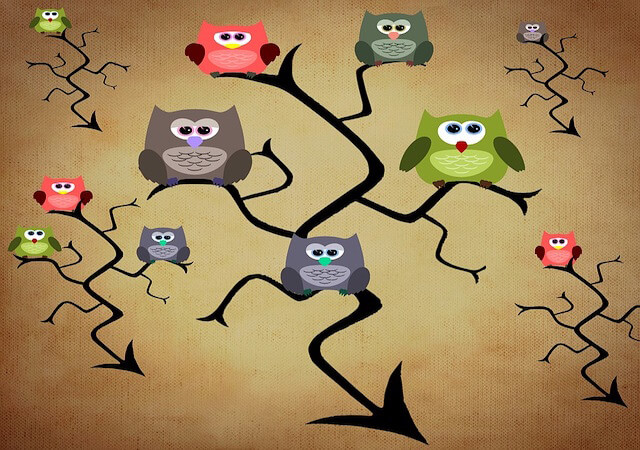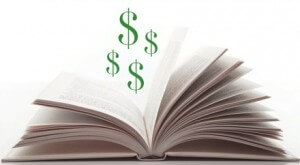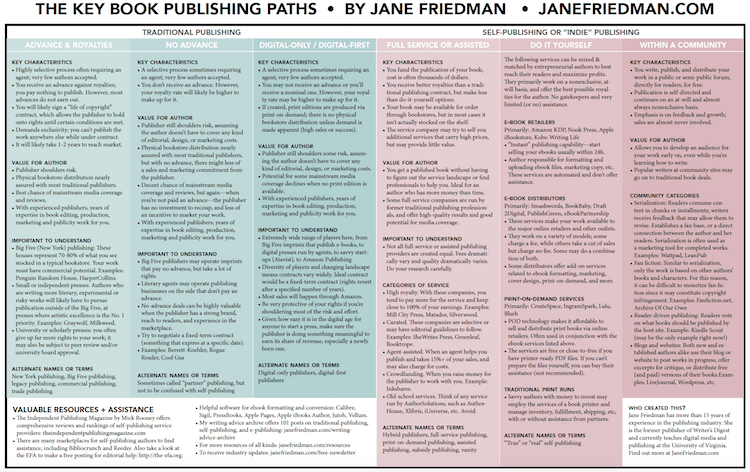 Why are publishing options the first topic we’d address in a series on author marketing? Because whichever successful publishing path you choose will directly impact the level of author marketing support you’ll receive from your publisher of choice, and will inform your marketing strategy as you move forward.
Why are publishing options the first topic we’d address in a series on author marketing? Because whichever successful publishing path you choose will directly impact the level of author marketing support you’ll receive from your publisher of choice, and will inform your marketing strategy as you move forward.
So, should you hold out for a traditional publishing deal, use a partner publisher (also sometimes called hybrid publisher), entertain the idea of small press or take the reins and self-publish?
Let’s take a look at each of the categories we most often see with our own clients, and the advantages/disadvantages they’ve experienced. Then, we strongly encourage you to visit the additional resources below, especially Jane Friedman’s 2015 updated infographic on different publishing options (click on image below to view/download pdf). It’s outstanding and offers plenty of additional well-presented, free information.
 Self Publishing or “DIY”
Self Publishing or “DIY”
Advantages: It’s all you, baby, and so are the profits. Not for the faint of heart, but totally makes sense if you’re going to do the bulk of your marketing online, or with “back of the room” sales (the latter of which is typical for non-fiction, professional speakers).
In other words, self-publishing models work incredibly well if you already have a conduit for marketing/selling/distributing your book(s) AND if you have access to quality, professional, economical services for all the ingredients that go into a well-crafted book. Those include:
- Editing
- Page layout/design
- Cover design and any interior graphic elements
- Metadata, front and back matter and ISBNs
- ebook conversion for digital books
- Audio conversion for audiobooks
- Marketing services
- Distribution/Sales
Another often overlooked advantage is the support you can find as an independent author from other indies who’ve been there, done that. But if you’re new to publishing, there is a learning curve, and it’s a steep one.
Finally, if you’re looking to get to market fast, this will always be your best option.
Disadvantages: You’ll need to assemble a team to accomplish all the things above, and front the funds to get them all done. If you don’t have the necessary elements lined up, or don’t spend the time to carefully vet your service providers, you could end up spending thousands of dollars and still end up with a sub-standard product.
Buyer beware: Many “self-published” company models offer paid services as part of their “packages” – and typically more goes into the selling of these packages than delivering what’s been sold. If you’re really going to do it yourself, you need to assemble your team of resources, not rely on steeply priced services that offer no guarantees or references.
And, if you’re a debut novelist who plans on marketing your work through book stores, they’re not typically keen on displaying/ordering/selling the work of self-published authors. We’ve even run into one bookstore who will remit store credit only for sales of self-published work that authors have to provide/consign themselves!
 Assisted or Partner Publishing
Assisted or Partner Publishing
Sometimes also called hybrid publishing, because it’s a cross between self and traditionally published models.
Advantages: You’ll have a publisher’s name behind you that can help you get book blurbs, signings, store distribution and more. A proper partner publisher will evenly split both costs of editing, cover design, graphics, ISBNs, etc., AND evenly split royalties. Typically you’ll retain rights to your work.
This type of publishing deal offers an author some peace of mind in that the publisher has “been around the barn” and knows the landscape. They have already gathered trusted resources for editing, layout, etc. They understand distribution models and the pricing structures needed to get into book stores.
Most important, they have skin in the game. Meaning, unlike buying your services outright, splitting the cost of them with the publisher puts some of the risk on them; you BOTH only recover your shared investment and profit on your book if that book sells.
This model seems to be used most successfully by small press publishers who also offer a traditional publishing model. Why? Because perhaps a book comes their way that they feel MAY sell, but it’s a debut author without much marketing expertise. They’re not willing to take the full risk of a traditional deal and spend all the money up front, but they do see the potential value of sharing those costs with the author and giving that author a chance to go out and prove themselves.
Often, if the author DOES prove their value in the marketplace, subsequent work of equal quality are then offered traditional deals. The big caveat: You’ll spend less, but still enjoy royalties of 40 – 50% (and up to 70% digital), and we’ve seen traditional deals from these publishers offer tiny or no advances, but still offer 25 – 50% royalties, a nice cut above the traditional royalties offered by small press and traditional publishers.
This model also lets you get to market faster than small press or traditional publishing, but we caution authors to give themselves at least six months’ lead time to arrange blurbs, pitch ARCs to reviewers, etc.
Disadvantages: You’ll spend some money up front, and typically on the folks that they recommend (so be comfortable with their team). This type publisher will provide limited marketing support (typically in the form of attending regional or national book shows, producing an author’s tip sheet, conducting marketing calls with the author, submitting an author’s work to competitions and/or generating the occasional press release). They will rely on you as the author to do most of the heavy lifting.
They also don’t have the same clout as the “big boys” when it comes to getting that strategic shelf space in book stores or the automatic “nod” from the big reviewers. And while we have the pleasure of working with a short-list of very good partner publishers, the sad fact is most of the others are really just self-published models charging for services and taking a greater percentage of your royalties into the bargain.
 Small Press Publishing
Small Press Publishing
We’re lumping university presses into this category because they share many similar characteristics, though university press guidelines may be somewhat more strict.
Advantages: Every author is a big fish in a small pond when it comes to small press. You’re less likely to get “lost in the shuffle,” an obvious advantage if you’re a debut author. Of the authors we’ve worked with who’ve contracted with small publishers, we’ve seen, across the board, attention to detail, quality editing and cover design, attractive final products, and the ability to “niche market” within their area of title expertise.
Meaning, a small press publisher of sports titles or cookbooks will have a number of titles they can simultaneously market to those sections in the book stores. A small press known for its literary fiction will appeal to stores/venues catering to lit fiction and book clubs. These publishers take into consideration what all they’ll publish in terms of how it affects their stable of titles for that year.
Small press and university presses take on the full cost of publishing your work, but of course the lion’s share of the marketing will still be on you. They’ll typically also offer small advances (we’ve seen these range from $250 – $2,000) but offer smaller royalty percentages than either self or partner models.
Dependent on the publisher and its reputation, they typically do have some advantage in getting titles into bookstores. Some have limited sales staff or work through agencies/distributors. They also carry a bit of “clout” in recommending authors/presenters for conferences and festivals, which can open doors to new audiences for an author.
What we admire most about the small press model (in the ones we’ve worked with) is their passion. That’s no small matter when it comes to feeling “well-published” as an author.
Disadvantages: You sign away your rights. Advances are tiny; royalties are, too. We’ve seen print royalties as little as 6% on up to 12.5%. This is often on a sliding scale, meaning for example an author may be offered 6-10% up to 5,000 or even 10,000 copies and 10-12% thereafter. Digital royalties are typically 25%.
The paltry royalties are the biggest downside. If you’re counting on a lot of ebook sales, for example, you’d need to sell nearly three times as many with a small press or traditional publisher as with the self or partnered models to make the same amount of money. On the print side it’s worse. For every hundred books a self-published author sells, you’ll need to sell a thousand to get the same royalty check.
And yes (sigh), as an emerging author, much of the marketing is still going to fall on… you guessed it, you.
Traditional Publishing
Advantages: With most of the titles in a bookstore coming from those big trad publishers, you’re pretty much guaranteed distribution. The advances can be bigger. True, if you’re an emerging author they’re not often going to be those big six-figure numbers we used to hear, unless you’re a major celebrity with an incredible platform.
A traditional publisher pays for everything on the production side, and typically has the expertise and best staff to put out the best product. You’ll have a full complement of experts all working towards production of your book.
They also have in-house PR and marketing and sales teams. And when it comes to those giant shows like BookExpo America, it’s the traditional publishers with all the floor space and the fifty-foot-tall book banners advertising the latest and greatest books and authors to the world.
Do they typically offer the most commercial success? Absolutely, but these days that commercial success seems reserved for those already successful. It’s easier to be a commercial success when the publisher is contracting with authors and celebrities who are already successful. Many new “break-out” success stories are coming from small presses and self-published authors, who THEN go and make traditional deals… offering them more commercial success, but only once they’ve already done all the heavy lifting…
Disadvantages: As in small press/university press, the publisher owns your rights. It’ll take you much longer (12-24 months) to have a finished product, as it goes through layers of editors, designers, etc. all juggling a schedule of many other books. If you’re a newbie, you’re not going to get the marketing and PR attention of a long-time, successful author or dubious achieving celebrity.
If you don’t do your marketing homework and your book doesn’t “earn out” that advance and sell to the expectation of the publishing team, it won’t be easy to get another trad deal. (It’s not easy even if you are successful). And, some publishing imprints are even advising authors that their “big” advance of $5,000 or $10,000 is meant to be put towards their own author marketing and PR.
Royalties again range from 6% on up to 15% for print (and perhaps a wee bit more for bigger authors and/or hardback titles) and 25% ebook. A percentage of this will go to your agent since none of the big imprints accept un-agented titles. (Small and partner presses have been to known to work with agents or without them.)
Which Path Will Serve YOUR Needs?
Again, this is never a purely objective decision. You may crave the robust royalties of being self-published. You might more enjoy the clout of being traditionally published. You could seek the comfort of working with a small press editor who “gets you” as an author.
Or, as one author at authorearnings.com put it recently:
“Publishing professionally, after all, is about building a readership and a long-term, decent-paying writing career. As an individual author, that’s really all I care about, regardless of which publication method I choose.”
It would stand to reason that the greater your own level of involvement and your royalty percentage, the more the bulk of the author marketing work will fall on your shoulders. But, across the board, if you’re looking to build your readership and that decent paying writer career, you’ll be expected to be adept at marketing your book!
Additional Resources:
- Jane Friedman: Her 2015 updated infographic, “The Key Book Publishing Paths” is an uber-handy resource to understand the key characteristics of traditional vs. self publishing. Click on the image below to view/download the infographic and learn more at her site:
https://janefriedman.com/infographic-5-key-book-publishing-paths/ - Joanna Penn: (The Creative Penn) offers a wonderful collection of articles on publishing options, particularly self publishing: http://www.thecreativepenn.com/publishing/
- Independent Publishing Magazine: Their service index offers reviews on a number of self-publishing companies (click on any of the publisher names to learn more about their specifics).
http://www.theindependentpublishingmagazine.com/2015/12/publishing-service-index-novemberdecember-2015.html - AuthorEarnings.com: This is a website by authors and for authors. They gather and share info so that writers can make informed decisions. Their statistics focus on ebook sales across a variety of publishing platforms: http://authorearnings.com




Solid information.
Thank you, John! Loving that we can get a bit more comprehensive w/ this series – response has been wonderful and much appreciated… Write on 🙂
Great article! Makes you really think of what you want to commit to! I preferred to be independently self published, after my third book I am now very comfortable with this method. Yes, I had to do a lot of research and yes it took time but it was so worth it. Each book becomes easier! Now completing my fourth book and love it!
Thanks, Eileen and congratulations on your success. Four books – wow! Write on and hope the rest of the series will spark even more success as an independent author…
Great overview of publishing options! Thank you, Shari.
Thanks, Joanne – Happy New Year and write on!